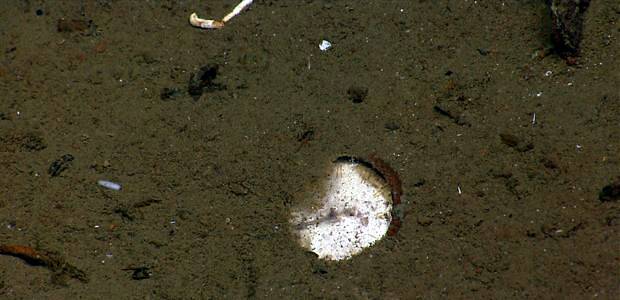Shipwreck expedition discovers ship’s timepiece silent for two centuries
Posted by Jayme Blaschke
University News Service
April 24, 2014
Recent deep water archaeological dives sponsored in part by The Meadows Center for Water and the Environment at Texas State University have uncovered a key artifact that may shed more light on three mysterious shipwrecks off the Texas coast.
Using undersea robots, satellites and high-speed Internet to send live video from the seafloor to audiences ashore, the team of marine archaeologists discovered a ship’s chronometer during the three-day Gulf of Mexico expedition partnership among The Meadows Center, the Office of Ocean Exploration and Research in the National Oceanic and Atmospheric Administration (NOAA), the Bureau of Ocean Energy Management (BOEM), the Bureau of Safety and Environmental Enforcement (BSEE), the Texas Historical Commission and the Maryland Historical Trust.
This was just the latest discovery made as part of the Gulf of Mexico expedition by NOAA Ship Okeanos Explorer. The expedition heads to investigate another potential shipwreck site on Thursday, April 24. The public is invited to view live video from the Gulf.

Undersea robots from the NOAA Ship Okeanos Explorer discovered a rare ship's chronometer in the remains of a shipwreck 200 miles off Galveston believed to be from the early 1800s. (Ocean Exploration Trust/Meadows Center for Water and the Environment)
"These sites never fail to amaze as to the preservation of the artifacts and what we continue to find intact on the sites," said Meadows Center underwater archaeologist Fritz Hanselmann. "Artifacts such as this chronometer serve as a tangible connection to our past and shed light on aspects of history that are unknown."
On April 17, pilots aboard NOAA Ship Okeanos Explorer guided camera-laden undersea robots, called remotely operated vehicles (ROVs), over the seafloor 200 miles off Galveston as scientists at sea and ashore directed the cameras to comb the remains of a shipwreck, believed to be from the early 1800s.
From an Exploration Command Center in Silver Spring, Md., Frank Cantelas, a marine archaeologist with NOAA’s Office of Ocean Exploration and Research, spotted a partly buried circular object on the live video. Cantelas, his colleague James Delgado, director of maritime heritage in NOAA’s Office of National Marine Sanctuaries, and other scientists were commenting on views of a ship’s octant--a navigator’s measuring instrument--that was nearly buried in sediment except for its mirrors. Suddenly Cantelas spotted this other object a few feet away. When the ROV’s cameras zeroed in, scientists were amazed to see the ancient timepiece. An expedition a year ago had missed the ship’s chronometer.
“Do you see a dial, and a hand inside the circle as well?” Delgado asked the team that day.
As the camera zoomed in, a scientist in Galveston added, “You can see Roman numerals.” The chronometer’s hand appeared to be pointing to 6:30.
In an Exploration Command Center at Stennis Space Center in Mississippi, Jack Irion, a regional historic preservation officer with the Bureau of Ocean Energy Management, said the chronometer’s discovery was rare and significant. While other evidence from the wreck suggests the ship predates 1825, it was unusual for merchant ships to have such an expensive instrument.
“For this to appear on a merchant ship in the Gulf of Mexico at this early date is extraordinary,” Irion said.
A British carpenter perfected the design for the chronometer in 1761--a clock that could keep accurate time on a rolling ship at sea, so that sailors could determine their position by measuring the angle of the sun relative to high noon in Greenwich, England. The devices were so expensive initially that few ships carried them. It wasn't until 1825 that British Royal Navy ships carried chronometers.
"This chronometer is an object worthy of scientific recovery, preservation treatment to reverse the corrosive effects of two centuries in the sea, detailed study and eventually, display in a museum," said Delgado.
NOAA explores the largely unknown ocean to obtain baseline information that is vital to informing decisions by ocean resource managers and policy makers. This includes investigating shipwrecks to determine if they may be significant national maritime heritage sites. Such sites require not only study, but protection in partnership with industry and other federal partners.
Anyone with a computer and Internet connection can join the expedition as a "virtual explorer, every day (except April 25), now through the end of April at: oceanexplorer.noaa.gov/okeanos/media/exstream/exstream_04.html Thus far during this expedition, there have been more than 490,000 views from shore of live streaming video from the seafloor.
For more information, contact Hanselmann at (512) 557-3949 or via email at fh16@txstate.edu, or Fred Gorell, public affairs for NOAA’s Office of Ocean Exploration and Research, at (301) 734-1021 or by email at fred.gorell@noaa.gov.